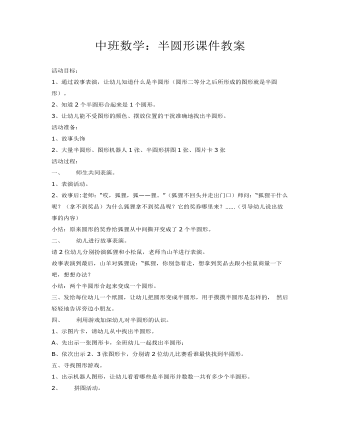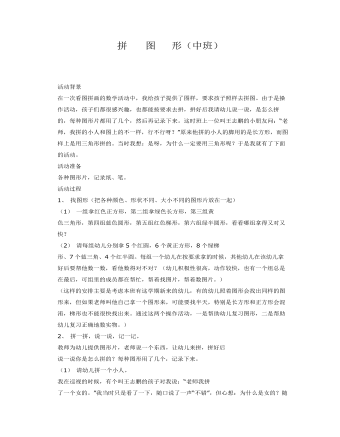-

中班数学:猜一猜课件教案
活动设计:游戏“猜一猜”活动准备:1.卡纸32张,大小各一对的图形(圆、三角形、正方形、长方形)、动物图片各一对。 2.卡纸16张,红色6张,黄、绿色各5张。(2份) 活动过程:(一) 介绍游戏规则和玩法: (将幼儿分成两队,把16张卡片按照横4张, 竖4张放好。图片朝下) 我们来玩个“猜一猜”游戏,怎么玩呢?我这儿有些大小不同、形状不同的图形,我依次翻,比如:我翻第一张是个苹果,记住这个位置上是个苹果,然后我把它关掉继续翻,如果你看到有张卡片是你前面看到过的,可以站起来告诉我“它有朋友了”并把它的朋友找出来,找对了,就给这队奖励,最后比比两队谁的奖励多就赢了。(教师依次翻卡片)

中班数学:橘子园课件教案
2,学习用数字表示物体的数量。二,活动准备:橘子园背景图;幼儿操作材料。一,活动过程:(一)认识数字31,出示果园图:今天我们去参观橘子园。问:你看到了什么?有几棵橘子树?幼儿随意观察图片,(互相交流讨论。)

中班数学:半圆形课件教案
2、知道2个半圆形合起来是1个圆形。3、让幼儿能不受图形的颜色、摆放位置的干扰准确地找出半圆形。活动准备:1、故事头饰2、大量半圆形、图形机器人1张、半圆形拼图1张、图片卡3张活动过程:一、 师生共同表演。1、表演活动。2、故事后:老师:“哎,狐狸,狐——狸。”(狐狸不回头并走出门口)师问:“狐狸干什么呢?(拿不到奖品)为什么狐狸拿不到奖品呢?它的奖券哪里来?……(引导幼儿说出故事的内容)小结:原来圆形的奖券给狐狸从中间撕开变成了2个半圆形。二、 幼儿进行故事表演。请2位幼儿分别扮演狐狸和小松鼠,老师当山羊进行表演。故事表演到最后,山羊对狐狸说:“狐狸,你别急着走,想拿到奖品去跟小松鼠商量一下吧,想想办法?小结:两个半圆形合起来变成一个圆形。

中班数学:拼图形课件教案
活动准备各种图形片,记录纸、笔。活动过程1、找图形(把各种颜色、形状不同、大小不同的图形片放在一起)(1)一组拿红色正方形,第二组拿绿色长方形,第三组黄色三角形,第四组蓝色圆形,第五组红色梯形,第六组绿半圆形,看看哪组拿得又对又快?(2)请每组幼儿分别拿5个红圆,6个黄正方形,8个绿梯形、7个蓝三角、4个红半圆。每组一个幼儿在按要求拿的时候,其他幼儿在该幼儿拿好后要帮他数一数,看他数得对不对?(幼儿积极性很高,动作较快,也有一个组总是在最后,可组里的成员都在帮忙,帮着找图片,帮着数图片。)(这样的安排主要是考虑本班有这学期新来的幼儿,有的幼儿照着图形会找出同样的图形来,但如果老师叫他自己拿一个图形来,可能要找半天,特别是长方形和正方形会混洧,梯形也不能很快找出来。通过这两个操作活动,一是帮助幼儿复习图形,二是帮助幼儿复习正确地数实物。)2、拼一拼,说一说,记一记。教师为幼儿提供图形片,老师说一个东西,让幼儿来拼,拼好后说一说你是怎么拼的?每种图形用了几个,记录下来。(1)请幼儿拼一个小人。我在巡视的时候,有个叫王志鹏的孩子对我说:“老师我拼了一个女的。”我当时只是看了一下,随口说了一声“不错”,但心想:为什么是女的?随后又去看其他幼儿拼的情况,这时由于受王志鹏小朋友的启发,我注意看其他孩子的,发现了孩子们拼的小人各有不同,全班只有几个孩子和别人拼的是一样的,其他都不相同。拼好后,我就先请王志鹏说一说,他是怎么拼的?王志鹏说:“我用圆形拼了这个女孩子的头,用正方形拼了她的身体,用长方形拼了她的手,用梯形拼了她的裙子……”张洁说:“我也拼了一个女孩子,是圆形拼了她的头,三角形拼了她的手和身体,梯形拼了她的裙子,腿被裙子挡住了。”也有好多是拼的女孩子,但他们不是体现在裙子上,而是体现在头上,如赵磊用两个半圆拼女孩子的辫子,冠晔是用两个圆拼了辫子……(就拼一个小人,幼儿就用不同的图形拼出了不同的女孩子而且每个孩子都能把自己拼的过程,用自己的语言表述出来。如果孩子不说给你听,你可能粗看一下还不能明白,但经孩子这么一讲解,当时真是恍然大悟,正如瑞吉欧所说:孩子有一百种语言,一百双手,一百个念头,一百种思考、游戏、说话的方式。)

中班数学:剥花生课件教案
为了进一步让孩子们去探索、发现花生的秘密,因此我预设了本次“剥花生”的活动。目的让幼儿在轻松愉快的活动氛围中,尝试学习用数字、符号来记录花生的数量,感知发现花生果里花生仁数量的不同。老师根据幼儿能力的不同,提出了不同层次的操作要求,使每个幼儿都能在原有的基础上得到提升。通过活动更让幼儿感受到劳动的乐趣,并与同伴共同分享成功的快乐。 活动目标:1、感知花生的特征,知道花生中花生仁的数量是不同的。2、学习用数字、符号记录花生的数量。3、尝试有计划、有条理地进行多次剥花生、做记录的活动。

中班数学:分家家课件教案
2、发展幼儿观察比较、积极思维及动手操作的能力。二、重点与难点: 用语言进行多维的命名。三、活动准备: 教师:大转盘一个,图形操作材料一套。 幼儿:人手一份图形操作材料。四、活动过程: (一)、初次尝试游戏“图形宝宝分家” 1、观察分类材料:看看盘子里有些什么?(有许多图形宝宝) 师:今天老师要和你们来玩一个“分家家”的游戏。 2、交代游戏名称与规则: 师:图形的家在哪里?(处示盘子)分成几家?(两家) 师:分的时候有要求,把相同的宝宝放一家,等一会儿把老师给你的图形宝宝分完,分好了取个名字记在心里,待会儿告诉老师。 3、幼儿操作“给图形宝宝分家”。 4、讨论:你们是怎么分的? (请几位幼儿走上来,师帮其操作结果贴出来)和他一样的有没有? 小结:分家家,可以根据图形的颜色来分成两家,可以根据形状分成两家,还可以根据大小分成两家。你们还想再试一次吗? (二)、再次尝试: 1、要求:等一会儿分家家的时候要求不一样了,再取两个好听的名字,要和现在的名字不一样。 2、幼儿操作提示:第一次怎么分的,第二次要分的不一样。 3、讨论:第一次怎么分的,第二次怎么分的?(请1-2名幼儿) 请幼儿和旁边的幼儿相互讲讲自己分的结果。

中班数学:比多少课件教案
二、重点和难点 让幼儿利用一一对应的方法发现两个物体集合之间的数量关系。 说明 一一对应是比较物休的集合是否相等的最简便、最直接的方式。通过一一对应,不仅可以比较出两个集合之间量的大小,更重要的是还可以发现相等关系,这是幼儿数概念产生的一个关键性步骤。因此,让幼儿在对材料的操作摆弄中自己“发明”一一对应的方法,并通过一一对应的方法去发现两个物体集合之间多、少和等量关系是至关重要的。 三、材料和环境创设 1.材料:诱发对应性材料--碗和调羹、杯子和杯盖、娃娃和帽子、小兔和青菜、……。自发对应性材料--雪花片和木珠、红积木和绿积木、苹果和香蕉、汽车和飞机等等。以上材料可用实物,也可用图片。 2.环境创设:将以上材料按难易程度编号放暨在数学活动区内供幼儿操作摆弄。

中班数学:丑丑虫课件教案
活动目标: 1.尝试按数取物设计虫子。2.能与同伴大胆交流自己的感受。3.乐于操作,体验创作的乐趣活动准备: 1、知识经验准备: 会操作电脑进行简单游戏、有过创作丑丑虫的经验。2、物质材料准备: 每人一张画有虫子外轮廓的画纸、带橡皮擦的铅笔每人一支、五官图片各一张。3、环境准备: 用幼儿自制的丑丑虫装饰虫子王国。

大班数学:玩骰子课件教案
2,发展分析问题的能力. 教学准备:大头子两个;小骰子,笔,记录纸,五角星若干.教学过程:一 看骰子 ---小朋友看一下老师手中拿的是什么东西?(小骰子)在哪里看到过? ---我们一起来看看骰子由几个面组成?每个面上的圆点都一样吗?(每人一个) 二 玩骰子 ---老师拿出一个大骰子轻轻的掷在地上,请小朋友看看是几点?是怎么看的?(看骰子 应该看最上面)-

中班数学:动物瓶课件教案
2.引导幼儿积极地与材料互动,培养良好的操作习惯。3.让幼儿体验数学活动的乐趣。活动准备:学具:空塑料瓶若干,黄豆若干,1-7不同数量的实物纸条,1-6的数字一组一份。教 具:1-6的数字卡、1-6的加点卡、动物图卡、大瓶子、背景图、头饰(火车头)、磁带。活动过程:1、以开火车游戏激发幼儿活动的兴趣。老师拿点子、数卡、动物图卡和孩子们进行问答游戏。师:嘿嘿,我的火车几点开?(师随机出示6以内的点卡、数卡)幼:嘿嘿,我的火车几点开。师:嘿嘿,来了几位小客人?(出示动物卡片)幼:嘿嘿,来了几位小客人。(反复进行几次)

大班数学:买礼物课件教案
活动目标:1、通过购买礼物这一活动,初步尝试合理安排钱币的方法。2、体验购物的乐趣。活动过程:1、谈话导入:新年马上就要到了,熊猫奶奶邀请我们去做客。

人教版新目标初中英语八年级下册If you go to the party, you’ll have a great time教案2篇
区分宾语从句、定于从句和状语从句宾语从句和状语从句,都叫做主从复合句。宾语从句主要是中考必考的,是初中阶段必掌握的从句,宾语从句主要是掌握三要素,所谓宾语从句,就是宾语在主从复合句当中充当宾语的一个句子,叫做宾语从句。主句的谓语动词是及物动词,后面如果是词或者是短语的话,是简单句,如果是句子的话,肯定是宾语从句。I know that he good at English.就是宾语从句,三要素,一要素是要注意连词,连词一共学了三类连词,一类连词是that口语当中可以省略,就像刚才说的那一句,I hear he is good at English.还有疑问代词、疑问副词,how where when,疑问代词、疑问副词。还有一类连词weather是否的意思,不是状语从句当中的如果,这一定要和如果区分开,这是是否。I don't know if he interested at English。宾语从句要注意if是连词。第二要素是语序,要用陈述举语序。比如说你家有几口人,我们都说How many people are there in you family?但是这是简单句,一旦说成宾语从句,你可以告诉我你家有几口人吗?Could you tell me how many people there are in you family ?

人教版新目标初中英语八年级下册Would you mind turning down the music教案
Step 4. Group work (4)1. Ask a pair of students to read the dialogue. Say, This activity provides speaking, listening and writing practice using the target language.2. Ask students to complete the work in groups.3. Check the answers with the whole class. 4. Explain some of the language points. Step 5. Word review (Self check 1)1. Ask students to read the words and the phrases given. 2. Fill in the blanks with proper forms of these words to complete the sentences. 3. Check the answers with the whole class. Homework:Do activity 2 on page 57 after class. Period 6Teaching aims: 1. Teach vocabulary words and the useful expressions. 2. Enable the students to learn etiquette in different culture. 3. Help the students learn how to behave politely in public places and in daily life. Teaching procedures:Step 1. RevisionHelp students to review the function of making requests through a free talk. Then lead them to the topic of etiquette. Explain the meaning of etiquette. Or, ask students to look it up in the dictionary. Step 2. Pre-reading (Section 1)1. Ask students to read the picture and make a list with their partner about how many rules of etiquette can be seen being broken.

人教版新目标初中英语九年级下册We’re trying to save the manatees教案2篇
本单元主要围绕着有关濒临灭绝的动物这一话题,学习了应该怎样保护我们的环境,以及就某一问题展开辩论。目标提示语言目标能够运用所学知识,就某一问题展开辩论。认知目标1、复习一些语法:现在进行时、一般现在时、用used to 表示一般过去时、现在完成时、一般过去时的被动语态。2、学会表达同意和不同意。3、学会以下基本句型:We’re trying to save the manatees.Manatees eat about 100 pounds of food a day.There used to be a lot of manatees.In 1972,it was discovered that they were endangered.Some of the swamps have become polluted.情感目标了解一些濒临灭绝的动物的生活习性和濒临灭绝的原因,教育学生应该如何保护环境。教学提示充分利用多媒体等教学设备,创设与本课话题相关的情境,如各种不同种类的动物、动物园以及有关环境的画画等等。围绕着本单元的教学目标,设计一些贴近学生实际的教学任务,如让学生谈论自己最喜欢的动物,如何拯救濒危动物,如何保护环境等等。让学生根据所学知识,就动物园是否对动物有利以及其他的话题进行辩论。

人教版新目标初中英语七年级下册How was your weekend教案2篇
Teaching Goal:1. General aims:Talk about recent past events2. Particular aims:A. Language Focus.Talk about recent past events and think of the past events.B. Language goalsHow was….?It was …What did …do over the weekend?C. Language structures:(1). How was your weekend? I was great. Pay attention to no form.(2). What did you do over the weekend? I played soccer. We went to the beach.D. Useful words and phrases:Words: was, did, went, beach, over, project, test, wasn’t, false, number, geography, spend, week, most, mixture, their, had, little, cook, read, saw, change, everyone, sit, sat, no, anythingPhrases: did one’s homework, played soccer, cleaned my room, went to the beach, played tennis, went to the movies, on Saturday morning, over the weekend, cook … for, what about, do some reading, have a party, talk show, go shoppingE. Grammar language:Present simple past tenseRegular and irregular verbsF. Learning strategies:Tour and holidaysG. Interdiscipinary:H. Emotion and manner:Teaching time: 5 periodsTeaching procedures:Period One教学步骤、时间 教师活动 学生活动 媒体应用Step 1Free talk 3’ Ask some questions like:Who’s on duty today?What’s the weather like? Answer and talk about something.让同学们回答下列问题1. Do you like weekend? (Let some students answer)It takes them three minutes to talk about the question.2. Why do you like weekend? (let the students answer) Most of the students like the weekend此时教师用汉语问:“在周末期间问你干了什么?这句话用英语这么回答?Let the students guess.At last the teacher give them right answer3. What did you do over the weekend?(板书、学习)

人教版新目标初中英语七年级下册What does he look like教案3篇
所需要用到的句子:Who is that?That is Jack. I like him.Why do you like him?I like him because he is interesting.Task 4: 设计理想中的人类Step one: 设计理想中的人类的外貌。把全班同学分成若干小组,学生可以边说边在纸上画出他们的模样。Step two: 设计理想中人类的性格。学生们可以把那些能描述性格的单词写在图画的旁边。Step three: 每组选出一名同学,其他同组同学提问,他作简单回答,并说明原因。所需用到的句子:What does he or she look like?He or she ...What is he or she like?He or she is ...Why?Because ...Task 5: 挑战性活动调查性格是天生的还是后天形成的,让每个同学回家去调查一下自己成长过程中性格是否有变化,具体是怎样的,为什么会这样? Teaching Aims:1. Enable students to have a general understanding of how to talk about people's physical appearance.2. Enable students to tackle some essential vocabularies and patterns about describing people. Provide them with necessary skills and methods.3. Create various chances for students to describe the persons they're familiar with, such as classmates, family members, teachers, idols, etc.

人教版新目标初中英语七年级下册Where is the post office教案2篇
Period 2 (3a----Section B 2c)Preview(Pre-task): Key points: What laAdd another information about their pen pals----their language on the cardnguage does she/he speak?She/He speaks....Does she/he have any brothers and sisters? Does she/he speak English?Preview(Pre-task): Add another information about their pen pals----their language on the cardKey points: What language does she/he speak?She/He speaks....Does she/he have any brothers and sisters? Does she/he speak English?Step 1 Revision1.Revisionand dictation of the new words 2.Revise the drills they learned yesterday.(by pairwork and grammar exercise)Step 2 Leading-inT has a conversation with one student. The conversation is following:---Do you have a pen pal?---Yes, I do.---What's your pen pal's name? ---His/Her name is....---Where is your pen pal from? ---He/She is from...---Where does he/she live? ---He/She lives in....---What language does he/she speak?He/She speaks...Write the new words on the Bb. They are following: EnglishChineseJapaneseFrenchStep 3 LearnLearn the new words with the whole class.Finish 3a with the students3b Pairwork T still does an example with one student Then the Ss practise in pairs. The example is following:--Curry Muray is my pen pal. He is from the United States.---What language does he speak?

人教版新目标初中英语七年级下册Don’t eat in class教案2篇
Don’t fight. =You can’t fight. (板书,教读)教师把这些句子板书在黑板上,并请学生大声整齐地读祈使句和“can’t”句型,并让学生注意两种句型表达形式的不同和转换,“Don’t …=You can’t…”;并对学生说:These are our school rules. (板书,教读) You can’t break the school rules. Don’t break the school rules.(板书,教读)步骤3 :Practicea. T: Now, each of the students is breaking one of these rules.Please finish 1a.学生看图,完成1a的内容,检查答案并大声朗读校规。b. 听录音,完成1b,选出四位学生都违反了哪条校规;听之前,学生要读会英文名。c. 请两位学生朗读1c部分的句型;要求学生两人一组对话表演,SA扮演外校转来新生,SB告知本校校规。(学生可经过讨论,多说出他们想到的校规,不必只限于书上;教师应给予帮助)2) 第二课时(2a~4)步骤1 :warming up of revisionT: What are the rules at your school?学生使用“can”或祈使句表达各条校规;其中老师可引出“eat in the cafeteria outside”的表达。步骤2 :Practicea.T: Christina is an exchange student. She doesn’t know the rules. Let’s listen, what activities they’re talking about?学生听第一遍时,完成2a;第二遍时,完成2b;b. 请学生领读2c部分,看着2a完成的表格,理解2c活动的要求;分成小组针对2a进行问答;

人教版新目标初中英语七年级下册I ’d like some noodles教案
教学过程Step 1: warming-up Sing a song---------“food and drink” Step 2: Revision1 Dictation2 Revise: What kind of noodles would you like?I’d like …What size bowl of noodles would you like?I’d like…Step 3: Presentation1 show pictures of food, ask students say the words.2 Students read the newspaper ad in 3a. Fill in blanks with words in the box. Then read the ad together, the teacher explains some difficult language points.3 Check the answers Step 4 PracticeAsk students to finish 3b in the same way according to 3a. Students read the short passage and fill in the blanks .At last, check the answers.Step 5 productionAsk students to write their own ad for dumplings, noodles, drinks, and other foods they know. Then ask students to read their partner’s ad. Then order food and drink from their partner.Step 6 Home workGroup work – make an ad about “food and drink”

人教版新目标初中英语七年级下册I want to be an actor教案2篇
三、教学建议第一课时:1. Lead in (Vocabulary)A) Before class, teacher should collect some pictures of working places. For example: Bank, TV Station, Restaurant, Police Station, Hospital ...B) In class, show students the pictures (PowerPoint, OHP). Ask students to tell the name of the working places and the name of the jobs.Shop assistant, doctor, actor, reporter, police office, waiter, bank clerk, studentC) Do exercise 1a and 3a.2. Bingo GameAsk groups of students to make up pairs of cards with a job on one and the related workplace on the other. For example, waiter / restaurant, teacher / school, doctor / hospital. Encourage students to use both the job / workplace combinations in the book and the ones that students came up during class discussions. Be sure they have twice as many sets of cards as there are students in the group. They can make two sets of cards for a single job / workplace, if necessary. Then have each group mix up its set of cards and hand their cards out in random order. Each time a student gets a pair of cards that match, he or she can lay these cards down. The goal is to have no cards in your hand at the end.3. Task OneA) Ask students to work in pairs and ask the partner what does he / she want to be in the future.e. g. :What do you / does he / does she want to be?I want to be a.Why?Because it's (adj).B) Vocabulary: Section B, 1a4. Homework 1.2.